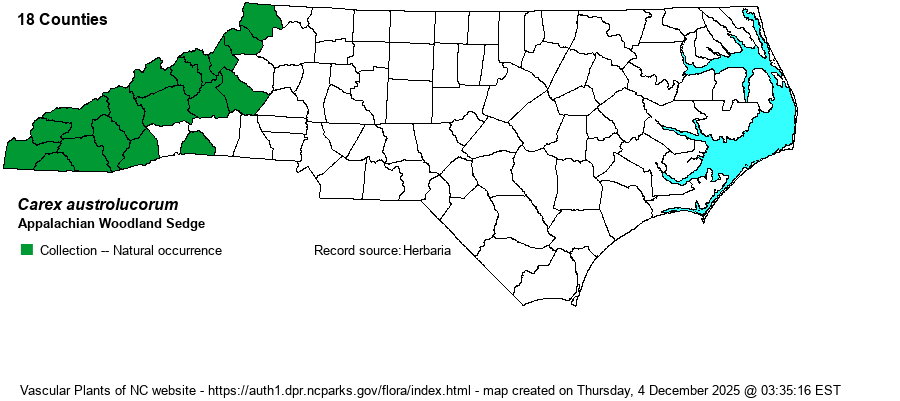| Section 5 » Family Cyperaceae |
Show/Hide Synonym
| taxonName | relationship | relatedTaxonName | relatedTaxonRefText | relComments |
|---|
| Carex austrolucorum | = | Carex lucorum var. austrolucorum | Flora of North America (1993b, 1997, 2000, 2002a, 2002b, 2003a, 2004b, 2005, 2006a, 2006b, 2006c, 2007a, 2009, 2010) | | | Carex austrolucorum | = | Carex lucorum var. austrolucorum | Kartesz (1999) | | | Carex austrolucorum | = | Carex lucorum var. austrolucorum | | | | Carex austrolucorum | = | Carex lucorum var. austrolucorum | Flora of Virginia | | | Carex austrolucorum | < | Carex pensylvanica var. distans | Fernald (1950) | misapplied as to our plants) | | Carex austrolucorum | < | Carex pensylvanica var. distans | Gleason (1952) | misapplied as to our plants) | | Carex austrolucorum | < | Carex pensylvanica var. distans | Radford, Ahles, and Bell (1968) | (the namemisapplied as to our plants) | | Carex austrolucorum | < | Carex lucorum | Gleason and Cronquist (1991) | | | Carex austrolucorum | < | Carex lucorum | Frye & Lea (2001). Key to sections adapted closely from FNA. | | | Carex austrolucorum | < | Carex lucorum | Small (1933, 1938) | | | Carex austrolucorum | < | Carex pensylvanica | Wofford (1989) | | | Carex austrolucorum | = | Carex lucorum ssp. austrolucorum | | | | Source: Weakley's Flora |
|
| Author | (J. Rettig) Poindexter & Naczi | |
| Distribution | Restricted to the Mountains. In 2016 Derick Poindexter annotated all specimens at UNC-Chapel Hill; these in Ashe, Buncombe, Cherokee, Clay, Graham, Haywood, Macon, Polk, Swain, Transylvania, and Watauga counties. Other SERNEC specimens are from other herbaria and represent Avery, Burke, Jackson, McDowell, Mitchell, and Yancey counties. They are likely correct, but need to be double-checked for ID.
Western VA and eastern TN south to northern GA. | |
| Abundance | Seemingly infrequent to locally numerous; abundant at a few sites. The NCNHP has recently (2021) removed the species from its Watch List. | |
| Habitat | Mesic to dry hardwoods and mixed hardwood-pine forests on slopes, the soils generally acidic. | |
| Phenology | Flowering and fruiting April-May. | |
| Identification | Belongs to a challenging group of sedges; experience is necessary for successful identification. Can be separated from C. lucorum by the leaves usually less than 1.5 mm wide (versus greater than 1.5 mm wide) and perigynia beaks averaging 1.5 mm long (vs. 1.3 mm in lucorum). | |
| Taxonomic Comments | This taxon was elevated to a full species recently; it formerly was C. lucorum var. austrolucorum. Derick Poindexter completed a PhD thesis on this thorny group of Carex.
The genus Carex is the largest in North America, and among the largest in the world. In temperate and boreal regions, Carex is often the dominant or co-dominant ground layer in many habitats. Seeds (achenes) are valuable food for birds and small mammals, while foliage is used by birds and mammals to make nests and as food by mammals. Species of Carex often look vastly different from one another -- spikes erect vs. drooping, tiny inflorescence vs. whopping, culms leafy vs. naked, perigynia beaked vs. beakless, stems densely bunched vs. single, etc. The genus has been divided into many sections (or groups), based on shared characters; some taxonomists have suggested that these be different genera, but that proves unworkable (so far). All Carex share the feature of a perigynium (an outer covering) which completely surrounds the achene (seed). This covering may fit tightly or loosely (like a small bladder), depending on which group or species. Details of perigynia shape, ornamentation, presence and size of beak, number of striations (or veins) are all important ID features. In recent years Rob Naczi and colleagues have stressed the importance of arrangement of perigynia -- whether spiral (3+ ranks) or distichous (2-ranked) -- and have named a number of new species as well as split off some older synonyms. Therefore, RAB's (1968) key, excellent for its time, can only be used in a general way today. Members of some sections of Carex are difficult to key out (notably Ovales, Laxiflorae, Griseae); this is in part due to variation among individuals of a species, or failings of the key. FNA has drawings of most species and some species may be found in two or more places within a key, to acount for variability. New species to NC, and new to science(!), continue to be found in NC. | |
| Other Common Name(s) | Blue Ridge Sedge -- a name usually reserved for C. lucorum (strict sense), which is more northerly and does not occur in NC. | |
| State Rank | S3S4 | |
| Global Rank | [G3G4] | |
| State Status | | |
| US Status | | |
| USACE-agcp | | |
| USACE-emp | | |

